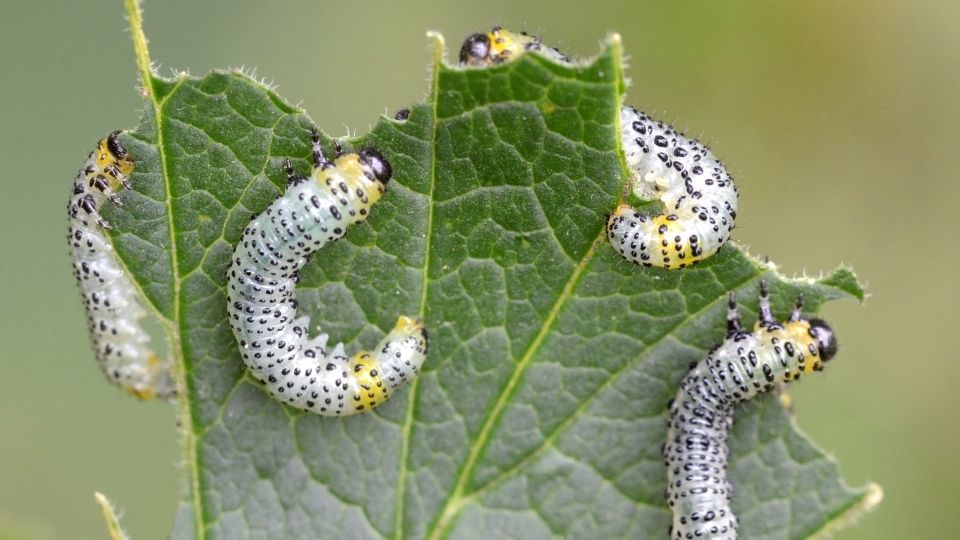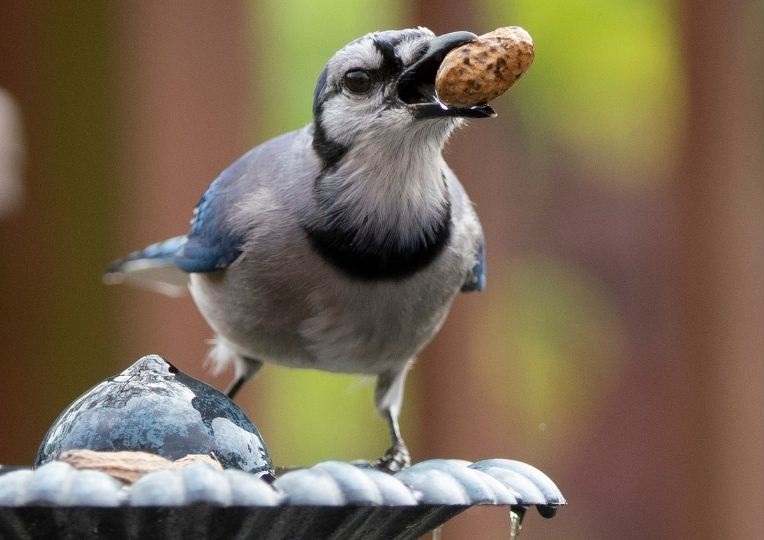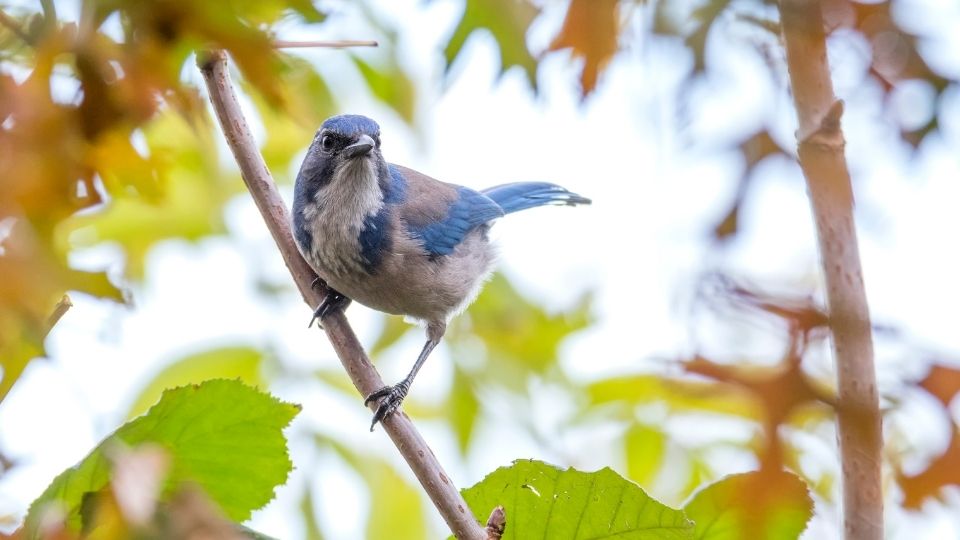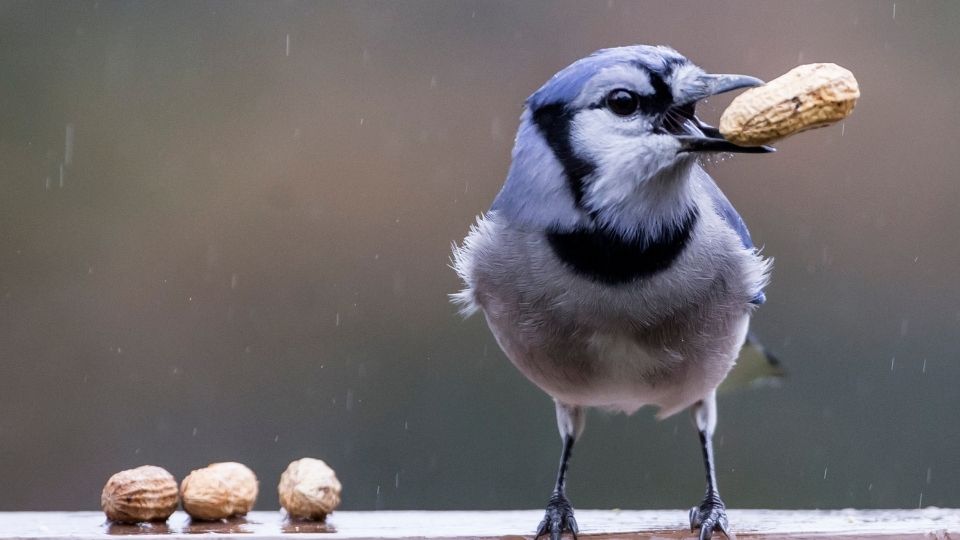Blue Jays are omnivores, and eat just about anything from meat to seeds. Foods that Blue Jays eat in the wild include acorns, mealworms, beechnuts, suet, and wild berries. Birdwatchers can provide Blue Jays with whole sunflower seeds, whole peanuts, and dried berries. Blue Jays will also eat fresh blackberries and cherries.
Many Blue Jay songbirds will happily partake in birdfeeder offerings like cracked corn and sunflower seeds, with peanuts being their favorite.
They also derive a lot of nourishment from bugs like caterpillars, grasshoppers, and even eggs from neighboring nests.
Do Blue Jays Eat Sunflower Seeds?
Yes, Feeders that contain a variety of seeds, including Sunflower seeds, are likely to attract Blue Jays. Blue Jays will hold a whole sunflower seed with its shell and crack it open using their beaks.
Because of their dense and powerful bills, Blue Jays can crack open many seeds with shells, such as Peanuts and Black Oil Sunflower Seeds.
Whether they eat them right off of the plant or in your birdfeeders, sunflower seeds provide ample protein and nutrition to these aesthetic blue birds.
Do Blue Jays Eat Acorns?
Blue Jays primarily live in the eastern United States, so they have an ample supply of acorns that they forage and eat frequently.
Since North America has the largest oak tree population in the world, acorns are an excellent food source for Blue Jays.
They even cache acorns in the ground to store for the winter.
When they forget about seed locations, they help boost the oak tree population in the United States.
In the video below, we rounded up 10 of the most fascinating facts about Blue Jays!
Do Blue Jays Eat Caterpillars?
Not all birds eat caterpillers, but caterpillars are a special treat for Blue Jays!
They’re very high in protein, easy to catch (and spot) and a perfect meal to feed their young.
In the springtime, blue jays are found hanging around trees waiting for a juicy caterpillar to pass by.
While caterpillars don’t make up their entire diet, they serve more as a delectable and rare treat than a full meal.

Do Blue Jays Eat Grasshoppers?
As far as bugs are concerned, grasshoppers are another tasty treat for Blue Jays.
Most Blue Jays eat a predominant seed and nut selection of food sources, but the grasshoppers are excellent sources of protein, especially for their young.
While Blue Jays do eat grasshoppers, they are not the only birds in town with a taste for them.
Woodpeckers also love grasshoppers, which means Blue Jays will be lucky to get their beaks on a juicy grasshopper.
Do Blue Jays Eat Mealworms?
Mealworms are another great source of nutrition to keep energy levels high in the summer months.
Mealworms provide the perfect blend of protein, fat, and fiber in an easy-to-catch package.
Blue Jays are intelligent birds and can find meal worms on their own without the need for a feeder.
However, in the wintertime, it’s super helpful for friends of Blue Jays to install a mealworm feeder or mealworm suet in their back yard.

Do Blue Jays Eat Whole Peanuts?
Peanuts are Blue Jays absolute favorite food. While many backyard bird enthusiasts leave peanuts out for squirrels, they soon discover that blue jays love them just as much- if not more!
If you want to feed peanuts to the Blue Jays in your yard with a peanut feeder, there’s no need to splurge on shelled peanuts.
Blue Jays can eat shelled peanuts by breaking the shell open with their beak.
They can even hold more than one peanut in their beak at a time, making quick work of a backyard peanut offering.
What Fruit Do Blue Jays Eat?
Blue Jays are known to eat wild berries such as mulberries, elderberries, and strawberries.
Be prepared to share if you have berry bushes planted in your backyard!
Blue Jays also love any fruit that you have left over in your fridge. They eat anything from watermelon, citrus fruit, apples, and peaches.
Before you leave out fruit for your fellow Blue Jays, be sure to slice it into smaller, manageable pieces that fit in their beaks.
What Do Baby Blue Jays Eat?
A baby Blue Jay’s diet is very similar to its parents.
Adult Blue Jays bring nestlings anything from birdseed, mealworms, corn kernels, and peanuts.
Young birds have a harder time digesting complex proteins from bugs, so their diet consists of grains, beechnuts, and seeds.
During, the nesting period, when a female Blue Jay is incubating her brood for about 17 days, the male Blue Jay will bring the partner food it has found.

How Do I Attract Blue Jays to My Backyard?
Unlike bluebirds or hummingbirds, it’s not too difficult to attract Blue Jays to your backyard feeders.
They love pretty much anything, and that includes a basic seed mix found at your local petstore.
If you still have not spotted any Blue Jays around your feeder by using sunflowers or cracked corn kernels, peanuts will do the trick!
Blue Jays love peanuts in any form. If you don’t have shelled peanuts or unshelled peanuts, good old-fashioned peanut butter works well too!
Lovely Bird Feeders
It’s also important to keep in mind that most Blue Jays are much larger than your average bird.
Most standard bird feeders are more equipped to accommodate Scrub Jays or House Finches – not Blue Jays.
They have difficulty perching on smaller bird feeds, so you need something that works for their frames.
Hopper feeders provide a larger perch for Blue Jays, making it easier for them to grab their favorite treats and fly away.
These styles of feeders also make it much easier to attract a wide array of birds, and you can place any seed in this feeder. It is also a great way to offer peanuts.
Unexpected Blue Jay Stashes
Blue Jays are known to stash food in various locations to reserve for winter. They take an acorn in its beat and bury it in the ground to save for winter.
More often than not, they forget where they stashed some of their food. Forgotten stashes are often why you find a random sunflower growing in the middle of your yard!
F.A.Q.
Are Blue Jays Considered Songbirds?
Yes, their most recognizable tune doesn’t sound like much of a song but rather like a loud jeer that wakes you from a dead sleep in the morning.
However, they also have something called a whisper song that is only detectable if you are really listening.
Their whisper song, as the name implies, is very soft and muffled and includes clicks, whines, and subtle liquid notes.
What is a Blue Jays Favorite Food?
Peanuts! Whether they are shelled or unshelled or in peanut butter form, Blue Jay will eat peanuts.
They provide all of the fat and protein needed to make it through the winter, and they don’t need to hunt them down like bugs.
What Can I Feed Wild Blue Jays?
Blue jays aren’t picky.
Your average mixed songbird seed is a great option, so long as you have a suitable feeder for them.
In the winter months, you can help your local Blue Jays with food that is high in protein and fat.
Be sure to leave out protein-heavy food such as mealworms. Suet with mealworms is an excellent choice.
If you don’t like the idea of mealworms, things like nuts are also great options.
What do Blue Jays Eat in Winter?
In the harsh winter, keeping energy levels high is a Blue Jay’s key to survival.
Many search for lost nuts and seeds from the fall harvest or retrieve stashes from the previous summer.
However, backyard birdfeeders are super important to Blue Jays. Ensure you keep your feeders stocked with goodies such as seeds, suet, and even mealworm this winter.

